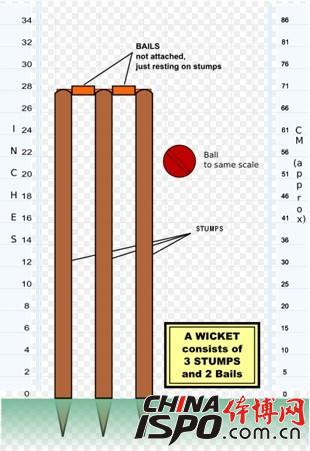Site introduction In the cricket game, the cricket pitch has a three-column gate - 1 chain or 22 yards (20.12 meters) long and 10 feet (3 meters) wide between the central dividers. The surface is very flat, usually covered with short grass, but the grass on both ends of the court will be worn away in the game. Cricket Ground Standard In amateur games, artificial fairways are often used. Some are concrete slabs, mats cover artificial turf, and sometimes the palm mats are covered with soil to provide realism to the course. Artificial pitches are rare in professional cricket matches and are only used in important exhibition matches in the region. In the cricket rules it is stipulated that there is a very specific area line on the course as a marker. The term tri-column often refers to the court. Although technically incorrect, according to the cricket rules (rule seven includes the difference between the court and the rule eighty-three columns), board players, followers, and commentators insist on using the ambiguity to eliminate any possible circumstances. The track is another synonym. The rectangle in the center of the court - the space used by the court, is called the square. Three-post door schematic protected area In the middle of the court is a protected or dangerous area - rectangular, two feet wide, 5 feet ahead of each pitch line. According to the cricket rules, the pitcher must avoid following up on passing the ball. If the pitcher runs in the protected area, the referee will warn the pitcher and the captain. If the pitcher fouls again, it is a second and final warning. For the third foul, the referee will make the pitcher out of the game so that he can't hit the ball again in the batting game. This kind of protection in the protected area is to prevent the ball on the court from rebounding in this area. If the stadium is worn out or damaged, the pitching party may have deliberately committed a foul and this should be judged according to the footprint of the pitcher. This rule does not prevent the pitcher or any outfielder who is trying to defend in a protected area. It only applies to situations where the ball is followed up continuously. National Stadium Natural damp long grass fairways are described as green fairways. This helps the pitcher cross the batter because the ball becomes irregular on long grass or wet grass. Most clubs and community cricket grounds, professional cricket players call it green. The damp three-column gate - the wetland course - caused the ball to move irregularly, especially the slower spinning ball. However, modern stadiums are generally rain-proof during the competition and are therefore not common in the first class competition. This sentence still maintains any difficult situation outside the current and cricket. As the game progressed, the stadium dried up. The rules of the cricket dictate that the court should be sprinkled during the game. When it dries, it will be easier to hit the ball initially because there is no moisture. After four or five days of play, the stadium began to crack and then turned into debris and dust. Such courses are commonly known as 'dust storm zones' or 'minefields'. However, this is good for bowlers, especially for players who are good at throwing spins. They can get a lot of traction through the surface of the ball and make the ball spin for a long time. When the status on the playing field changes and the game is one of the top strategic considerations, it is relatively difficult for the batters and the players. The team’s main players will decide on the coin, which will ultimately determine which team took the lead. ball. Site coverage The stadium needs protection. The administrator covers it to prevent rain. The issue of whether or not the cover is used will obviously affect the ball's departure from the court. This issue may be controversial. Article 11 of the cricket rules shall not cover the venue completely during the match unless otherwise specified or passed prior to the agreement. If possible, keep the venue dry even if the player is playing in bad weather. If the site is covered overnight, the cover needs to be removed as soon as possible before the morning game. If it is only used for protection against bad weather or if it is to be removed at night in the event of such weather delays, the faster, the better, if possible. Machines used to remove excess water from the field or off-site are called suction machines. competition rules Ball throwing During the game, the captain of the batting party may request that the rotation time of the court before the start of each round shall not exceed 7 minutes (except for the first game of this game and the next few days before the start of the game). In addition, if the kick-off is delayed in the first inning after the throw and before the game, the hitting side may require no more than 7 minutes to rotate the throw. Unless the referees agree, the delay does not have a significant impact on the course conditions. Once the game starts, this type of throwing will not happen in this case. If more than one swing is available, the captain of the shot should have choice. There are detailed rules to ensure that the ball-throwing method is feasible, so as not to delay the game, but if necessary, the game is delayed and the team captain is allowed to have a 7-minute ball-throwing time. Typical course The Australian Stadium has historically been called the best venue for quickball because it can generate rebounds from the ground. In particular, the Perth's Western Australian Cricket Association Stadium is considered to be probably the fastest track in the world. Brisbane Gaba is also known as a place to help pitchers quickly rebound. However, these kinds of elastic courses are also used to promote the development of more scoring runs such as pulling, hooking, and stealing. There are many examples of good examples of hitters hitting the ball on the court. Grenada Cricket Ground
Big or small, furry, finned, or feathered, pets are part of the family. Help your customers give them the treatment they deserve with pet food packaging that protects your product`s flavor and aroma. SomiPack provides specific packaging options for every kind of pet product, including dog food and treats, birdseed, kitty litter, vitamins and supplements for animals, and more.
Every pet product should be packaged in a way that works well and looks good. We work with you to determine the best packaging style for your pet supplies, including flexible box bags, barrier bags, vacuum bags, zippered Stand Up Pouches, and spouted stand up pouches.
Each style is made specifically for its unique contents with different combinations of film laminated together to create the right barrier properties. With our pet supply packaging, your product is protected from moisture, vapor, odor, and puncture. That means that the lucky pet gets the full flavor and texture that you intended.
With SomiPack, you can get the right style, in the right size, with the right look and the right price point. Our pet food packaging can be printed in up to 12 colors on clear film, metalized, and foil structures. And like all of our products, you can rest assured that your pet food packaging meets our exacting standards:
l Food grade material
l Water-based inks
l High quality rating
l Excellent print quality, regardless of order size
l Recyclable and landfill friendly
Your customers want the best for their pets. Make sure your product looks, works, and tastes great with pet supply packaging from SomiPack.
Bakers Dog Food Pouches,Dog Food Packaging Pouch,Dog Food Flat Bottom Pouch,Dog Food Gusseted Bag Chaozhou Chao'an Xinmin Food Packaging Co., Ltd. , https://www.somipack.com

